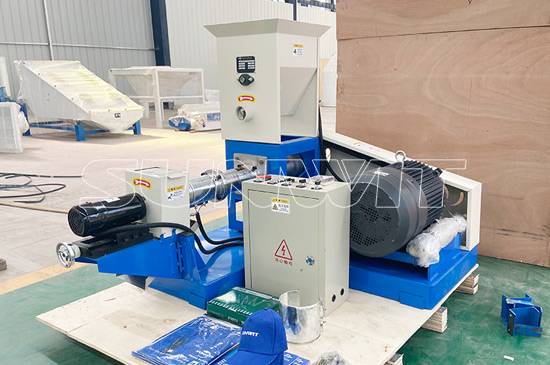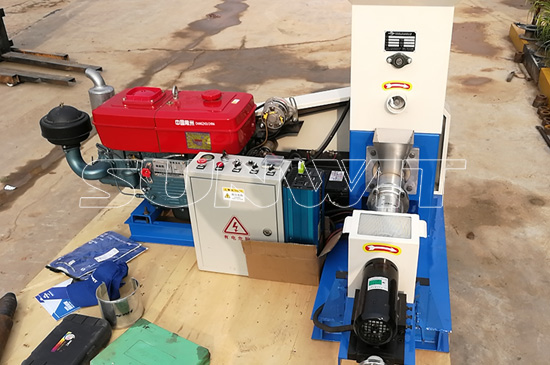This floating fish feed machine also called dry type fish feed machine is widely used for producing high-grade aquatic feed pellets for fish, catfish, shrimps, crab etc. It has become the ideal equipment for small and medium-sized fish farms and fish feed processing plants.

Sunwit is a professional fish feed machine manufacturer, if you want to make you own feed or build your own fish feed production line. Please contact us!
We Also Have Diesel Engine Floating Fish Feed Machine

Specifications of Fish Feed Extruder
| Model | Capacity(T/H) | Main Power(KW) | Feeding Power(KW) | Screw Diameter(MM) | Cutting Power(KW) |
| SFE40-C | 0.03-0.04 | 5.5 | 0.4 | Φ40 | 0.4 |
| SFE50-C | 0.06-0.08 | 7.5-11 | 0.4 | Φ50 | 0.4 |
| SFE60-C | 0.1-0.15 | 15 | 0.4 | Φ60 | 0.4 |
| SFE70-B | 0.18-0.2 | 18.5 | 0.4 | Φ70 | 0.4 |
| SFE80-B | 0.2-0.3 | 22 | 0.4 | Φ80 | 0.6 |
| SFE90-B | 0.3-0.4 | 37 | 0.6 | Φ90 | 0.8 |
| SDSP120-B | 0.5-0.8 | 55 | 0.6 | Φ120 | 1.5 |
| SDSP135-B | 1.0-1.5 | 75 | 0.8 | Φ133 | 2.2 |
| SDSP160-B | 1.8-2.0 | 90 | 1.1 | Φ155 | 3.0 |
| SDSP200-B | 3.0-4.0 | 132 | 1.5 | Φ195 | 3.0-4.0 |
Features of this Dry Floating Fish Feed Machine
- The fish feed pellet machine adopts international advanced technology, and the pellets are even.
- Can produce particles of different sizes and lengths (diameter from 1mm to 8mm).
- Electric heating device to increase feed expansion rate.
- High temperature and high pressure can kill salmonellosis and bacterial infections.
- Can produce high protein animal feed, easy to digest.
- Floating fish feed pellet machine can not only cooperate with the motor, but also with the diesel engine to meet the needs of customers place without electricity.
- This fish feed pellet extruder is also suitable for making feed pellets such as rabbits and ducks. Pellet feed is more economical than compound feed.
- A variety of raw materials can be used to produce pellet feed.
Floating Fish Feed Production Process
What are the Advantages of Floating Fish Feed
• High Nutrition Retention – Floating fish feed stays on the water for a long time. When the feed is dissolved in water, it will lose some nutritional value. Floating fish feed can reduce the loss of materials caused by water, mud and waste by about 20%. Good quality fish feed floats on the water for at least 10 hours.
• Environment-friendly – Floating fish feed is very easy to monitor. Even some of the remaining feed can be picked up and dried for later use, which also helps to keep the water clean. This is very beneficial to the growth of fish and environmental protection.
• Easy to Store – Due to high temperature and pressure expansion, the water content of floating feed (8-9%) is very low. This is why the feed pellets are hard and stable. In addition, due to its low moisture content, it is easier to store.
• Best for a Young Fish Breed – Floating fish feed is easy to digest due to its loose pellet structure. Therefore, this is very useful when you are dealing with small fish.
• Monitoring the Fish – Feeding floating fish feed helps to monitor the appetite of the fish because the fish can be seen from the shore while eating. In addition, the health and vitality of the fish can be regularly observed.
What are the ingredients in fish food?
There are many ingredients in fish feed formulated to provide sufficient nutrients for the fish growth development while promoting great health.
Among the common ingredients in fish feed are:
Protein source – Fishmeal, fish trimming, poultry by-products, soybean meal, feather meal and latest ingredients to be commercialised are algae, bacterial protein and insects
Lipid source – Fish oil, palm oil, canola oil, poultry oil
Carbohydrate source – rice bran, wheat meal, corn meal
Vitamins and minerals
Antioxidant – Carotenoid such as astaxanthin.
These ingredients will be included in their feed and formulated according to their nutritional requirement. It will depend on the species (marine / freshwater), water temperature, size and the system in which they were reared.
Fish Feed Extrusion Process
Commercial fish feed extrusion process refers to the cooked fish feed mixture under high temperature, steam and high pressure through a fish feed extruder in a short time, where high temperature is friction (dry extrusion) or pretreatment and steam injection (wet extrusion).
Dry type extrusion process: In the extrusion process, the heat generated by friction is used to heat the material, so that the material passes through the die hole under the action of screw extrusion. After the die hole is extruded, the pressure of the material drops sharply and the water evaporates, thereby achieving the purpose of extrusion. Throughout the process, the moisture content has been around 15%-20%.
Wet type extrusion process: Its principle is similar to dry type extrusion, but since the temperature increase of the material depends on the addition of steam, it is necessary to increase the moisture and steam to make the moisture reach 20% or even 30%.
